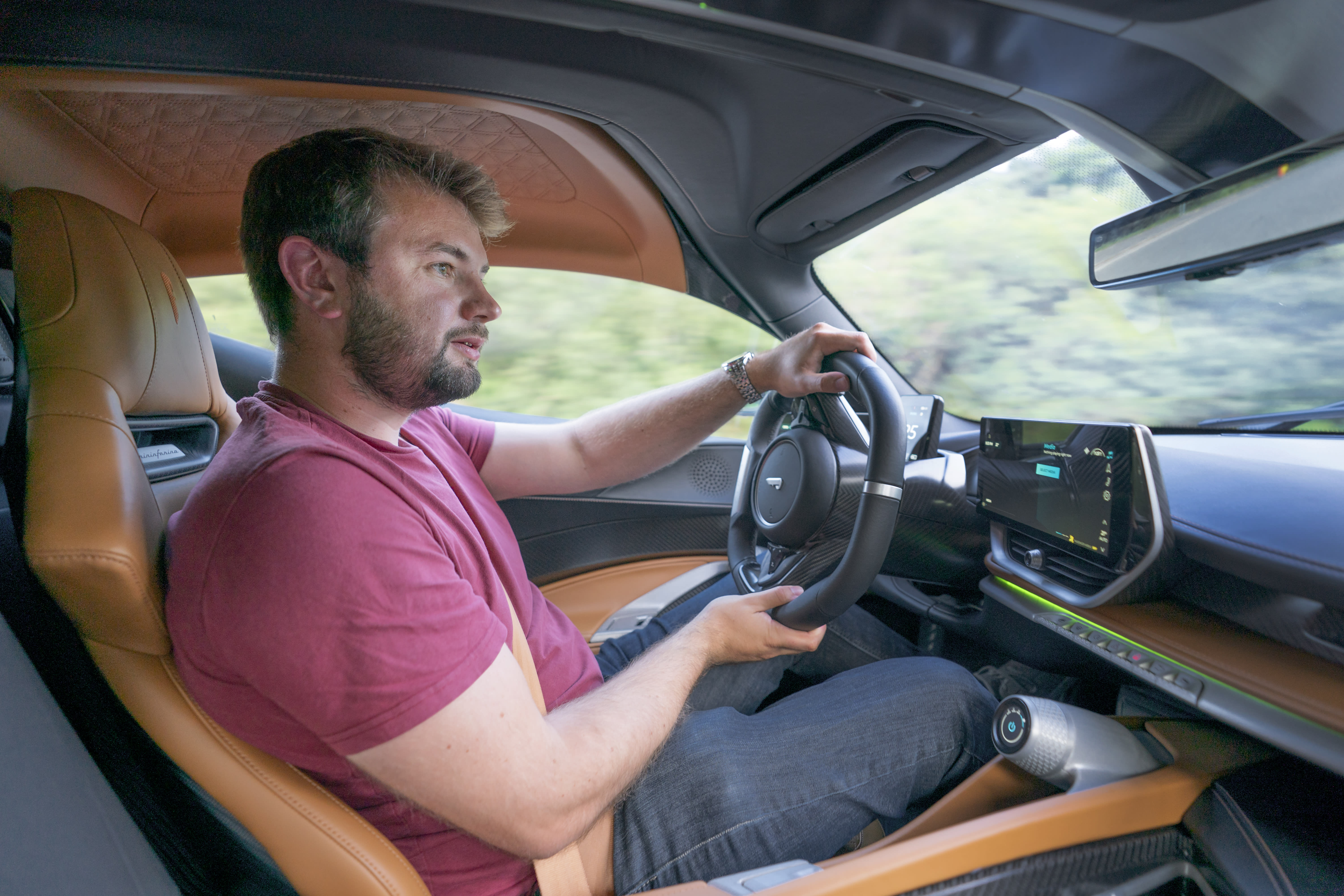
Volkswagen ID.7 (2024-) Review

Introduction
Volkswagen’s ID. range of electric cars is beginning to gain traction in the market, with the ID.3 and the ID.4/ID.5 siblings all proving popular with consumers. Now, the line-up is growing to include the ID.7 saloon, which is billed as an electric alternative to the Passat and the Skoda Superb.
However, that means this big VW is up against the likes of Tesla and Polestar, both of whom are big players in the electric saloon market. So will VW’s promise of long-range batteries, improved infotainment systems and an impressive standard specification be enough to ensure the ID.7 can challenge, or will the newcomer be left behind by its high-tech rivals?
Select's rating score* - 4 / 5
At a Glance
For anyone familiar with Volkswagen’s ID. range of cars, it’s immediately apparent what the ID.7 is. Although it’s lower and longer than an ID.5 coupe-SUV, it’s clearly cut from the same cloth, offering customers all the ID.5’s tech and zero-emissions-at-the-tailpipe goodness in something roughly the size and shape of an executive saloon.
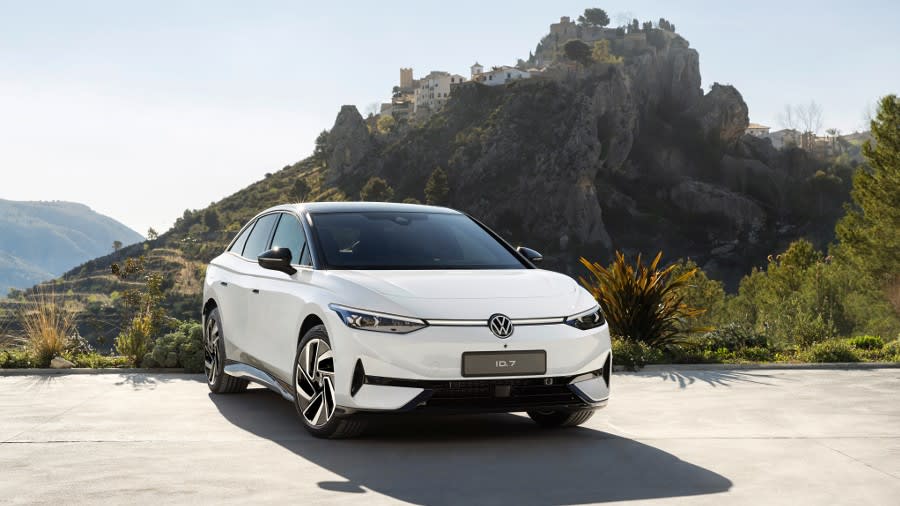
But the ID.7 is more than that, because it’s a more compelling choice than the ID.5, or indeed any other ID. model. Where the ID.3, ID.4 and ID.5 have all been let down by slightly below-par cabins, the ID.7’s interior is right where it ought to be, with a more premium design and feel than any of VW’s other electric models to date. It feels like a VW should. And it has improved technology, too, thanks to the massive new touchscreen and the huge head-up display that comes as standard.
More importantly, the lower, more aerodynamic body than the ID.4 and ID.5 models means the ID.7 has massively impressive range. Although the car has launched only with the smaller 77kWh battery, it’s still capable of well over 300 miles on a single charge, and rapid charging capability means filling it up won’t take too long.
Combine that with a mature, comfortable ride, good looks and ample practicality, and the ID.7 feels like a very promising electric saloon. It’s an incredibly easy car to get along with, almost completely free of major flaws, and that will be more than enough to ensure its popularity.
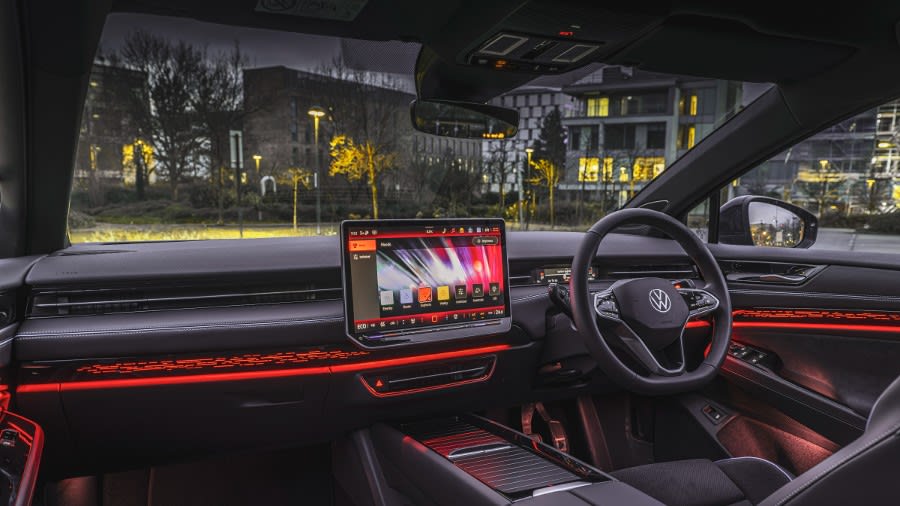
Key Features
Tech plays a key role in the ID.7 experience, and central to that is the massive 15-inch touchscreen in the middle of the dashboard. Using Volkswagen’s latest technology, the system offers easier navigation of menus than that of earlier ID. models, and it provides the Ida voice assistant. However, our tests found that system to be almost entirely disobedient, so it’s a good job the new touchscreen is more user-friendly than VW’s older systems.
More convincing is the head-up display, which projects information almost all the way across the windscreen. The system uses augmented reality technology to pick out the lines in the road, mark other vehicles and project navigation turn instructions on the windscreen as if they’re in the real world.
But for all the technology in the ID.7, the space is one of the biggest draws for the saloon. There’s loads of rear legroom and a massive boot, although there’s no cargo bay under the bonnet and the glovebox is miniscule. Admittedly, the rear headroom is a little tight for tall passengers, but it’s fine for most and the enormous luggage compartment is certainly a consolation. And Volkswagen will be bringing out an even more practical estate version next year.
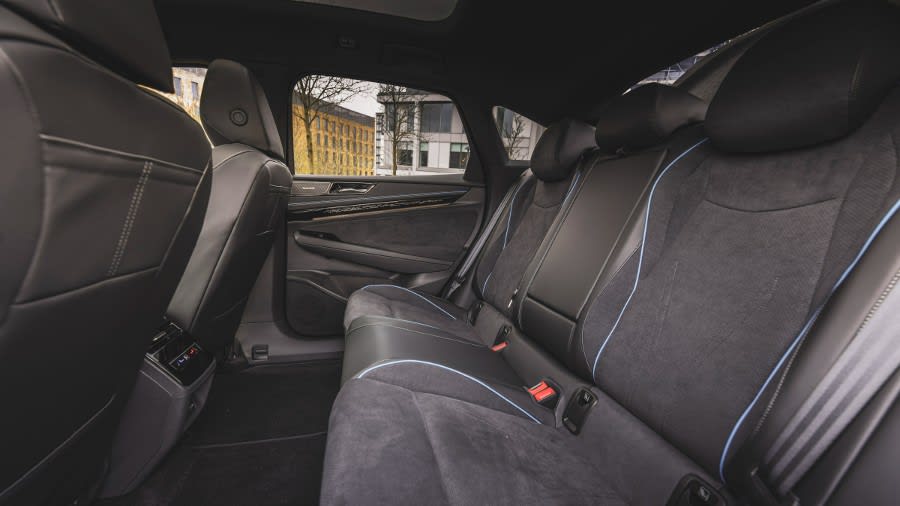
Range & Batteries
At launch, just one version of the ID.7 is available, complete with an 82kWh lithium-ion battery pack. And although just 77kWh of that capacity is usable, that’s enough for a range of 384 miles on the official economy test. Admittedly, in the real world, that’s probably going to work out at around 250-270 miles over a mixture of roads, and perhaps 220 on a motorway cruise, although those figures will change depending on the weather and the way you drive.
Those who regularly drive longer distances, however, might feel the need to choose the slightly larger battery found in the upcoming ID.7 Pro S, which has a usable capacity of 86kWh. That will likely mean a range of more than 400 miles, which should be plenty for most drivers.
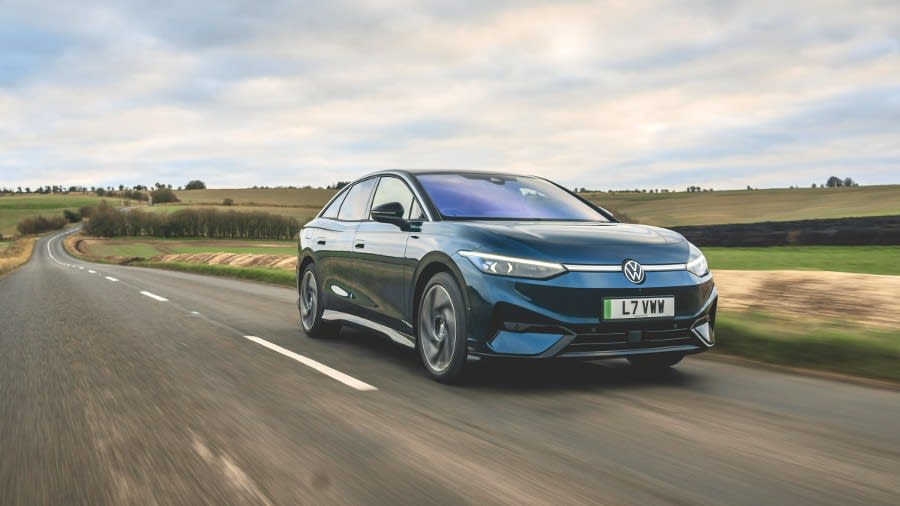
Performance & Drive
At launch, just one propulsion system is available for the ID.7, but that’s set to change as time goes on. Nevertheless, the introductory ‘Pro’ option is likely to be popular, with a perfectly ample 286hp heading to the rear wheels. That power is enough to permit a 6.5-second dash from 0-62mph, and a top speed of 112mph. With time, though, other models will arrive, and we’re expecting a two-motor, all-wheel-drive, high-performance model to join the range at a later date.
Before that, however, we’re expecting another rear-drive, single-motor variant to join the Pro in the line-up. The Pro S will essentially offer a bigger battery than the Pro, but it’ll get the same 286hp electric motor on the rear axle. That means performance is expected to be the same as that of the Pro, but range will increase.
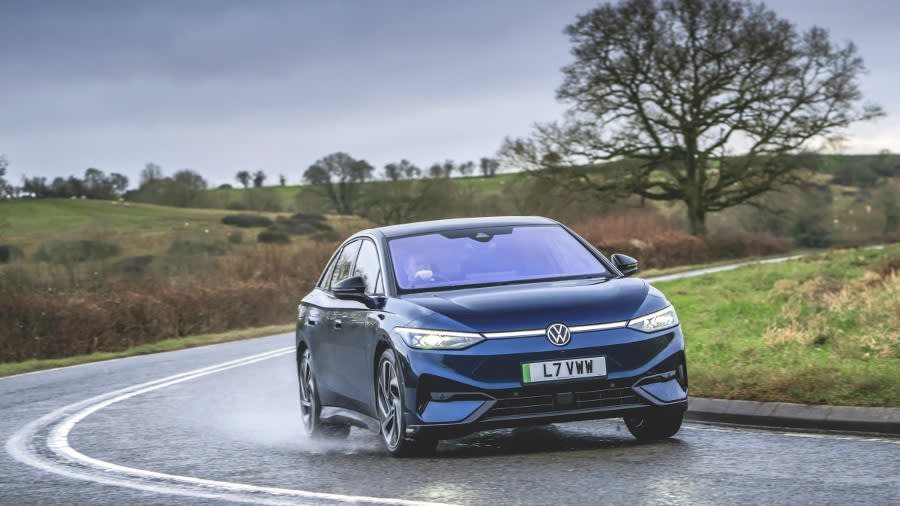
Whatever you go for, though, the ID.7’s driving experience will remain much the same, with a suspension set-up that’s clearly more focussed on comfort than sportiness. The ride is supple and mature, with only the worst potholes having any great impact on the cabin. It isn’t a magic carpet – big wheels and a heavy battery see to that – but it feels very composed at any speed. It’s at its best on the motorway, though, where it feels much more cossetting than an ID.4 or ID.5.
The handling isn’t so impressive, however, because light, numb steering ensures you never feel all that connected to the car. But the responses are linear and predictable, and the ID.7 has much better body control than its SUV-shaped stablemates, which means it rolls less in corners. It isn’t especially spectacular in the way it behaves, although the rear-wheel-drive layout means there’s a bit of slip from the rear wheels if you’re too greedy with the power, but the safety systems kick in before it gets too sideways.
That’s a bit of a metaphor for the whole experience, which feels very stable, safe and relaxing, but it never borders on exciting.
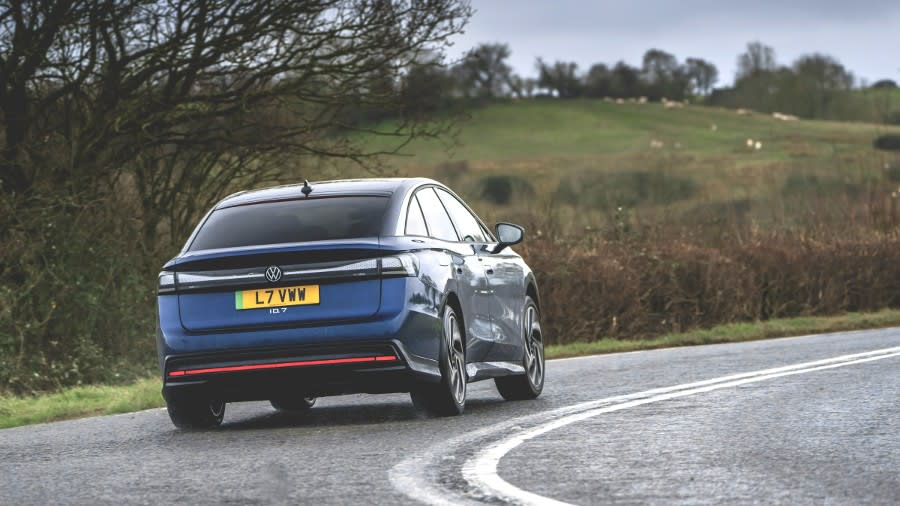
Charging
VW has given the ‘basic’ Pro version of the ID.7 a 170kW charging system, which means it takes less than half an hour to charge the battery from just 5% to 80% state of charge. Although naturally, that depends on you finding a charger quick enough to do that. Using a 7kW domestic ‘wallbox’ charging unit, though, should allow you to fill the battery overnight without too much trouble.
When the Pro S model arrives, however, it will bring with it the option of 200kW charging. Obviously, because of the bigger battery, the Pro S won’t actually be much faster to charge, but the extra speed allows it to manage the same 5-80% charge speed as the Pro — it’s just the Pro S will take you a little further with that energy.
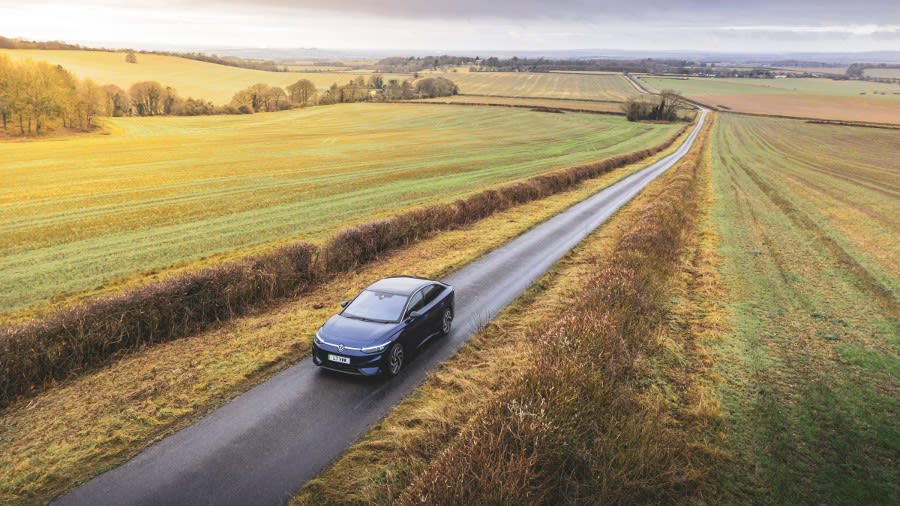
Running Costs & Emissions
With only electric powertrains — and efficient ones, at that — to worry about, the ID.7 is unlikely to break the bank from day to day. For those who can charge at home, very few journeys are likely to need more than one charge’s worth of go-juice, so running costs will usually be very low. And even when using rapid chargers, the ID.7 will likely be topped up for less than the cost of a 200hp petrol car.
For many electric car customers, though, the big draw will not be the prospect of low fuel bills, but of low tax bills. The ID.7’s zero-emission powertrains mean it’ll cost almost nothing in Benefit-in-Kind tax, while the semi-premium image and long range make it ideal for company car drivers. Expect it to be a common sight in business park car parks.
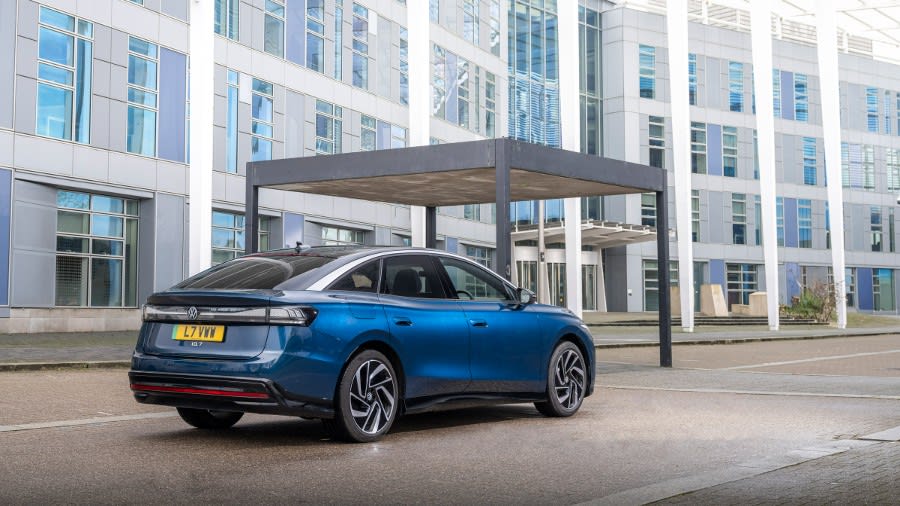
Interior & Technology
For other models in the ID. range (think ID.3, ID.4 and ID.5), the interior has been something of a let-down. Obviously, they’ve been fine in a Teutonic, underwhelming kind of way, but they’ve often felt a bit barren and not really up to the standards seen in other VW products.
Well, the ID.7 is absolutely nothing like that. The dashboard is soft and tactile and illuminated with gorgeous ambient lighting that has a surprising impact on the mood in the car. Supple materials wrap around everything, and the build quality represents a return to form for a brand that seemed to have lost its way a little.
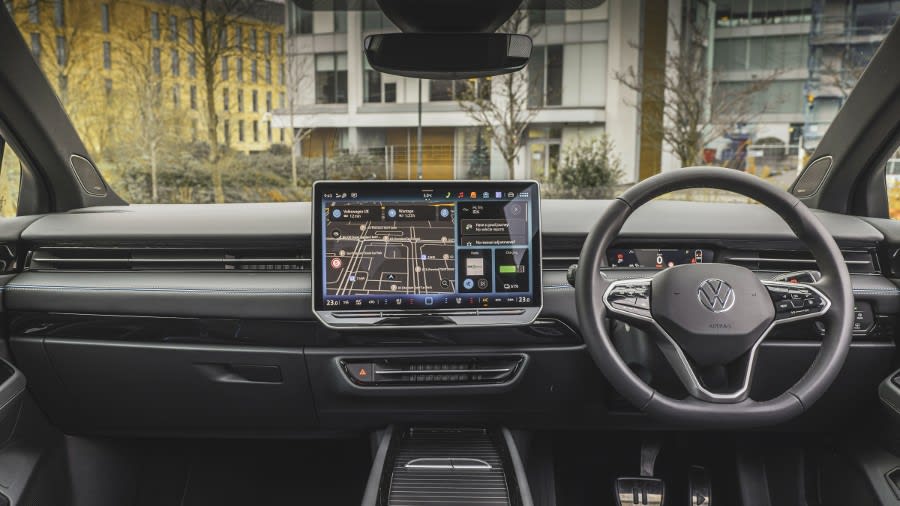
Not that the ID.7 isn’t without its ergonomic issues. The column-mounted gear selector feels clunky, the buttons on the steering wheel feel odd and the touch-sensitive sliders on the dashboard, while better than those in the ID.3 (predominantly because they’re now illuminated so you can use them at night), still feel clunky and inaccurate. Apparently, they’re an experiment with which VW is unlikely to persevere for long.
But there are signs of improvement in the shape of the massive central touchscreen. A standard feature across the ID.3 range, it houses pretty much everything you expect to find in a touchscreen, plus everything you might normally expect to be controlled by buttons on the dashboard. Climate control, vehicle drive modes and pretty much anything that doesn’t have to be button-operated by law lives in there.
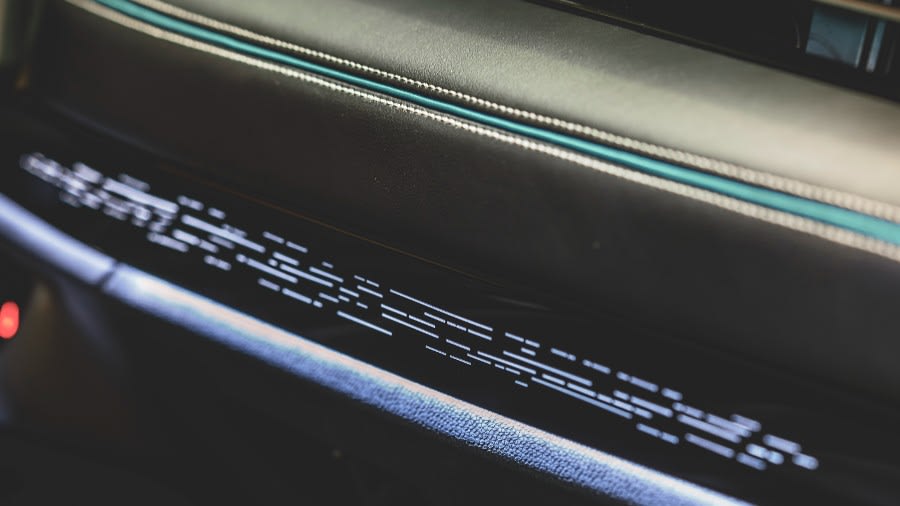
However, VW’s touchscreens haven’t been brilliant of late, and the company claims to have made some improvements for the ID.7. Chief among these is a new taskbar set-up that allows drivers to put customised shortcuts at the top and bottom of the screen, making for easier access to regularly used functions. Add in some swanky new graphics and features, and you’ve got something that’s much better than the systems fitted to other ID. products, but still isn’t quite class-leading.
That is paired with a massive head-up display, though, and that’s much more impressive. Spanning a huge section of the windscreen and fitted to all ID.7s as standard, the system gives drivers augmented reality displays by projecting icons onto the windscreen, allowing the car to pick out hazards, lines in the road, and turning points, then show them all to the driver as if they’re there in the outside world. It’s clever stuff, especially when it isn’t an optional extra.
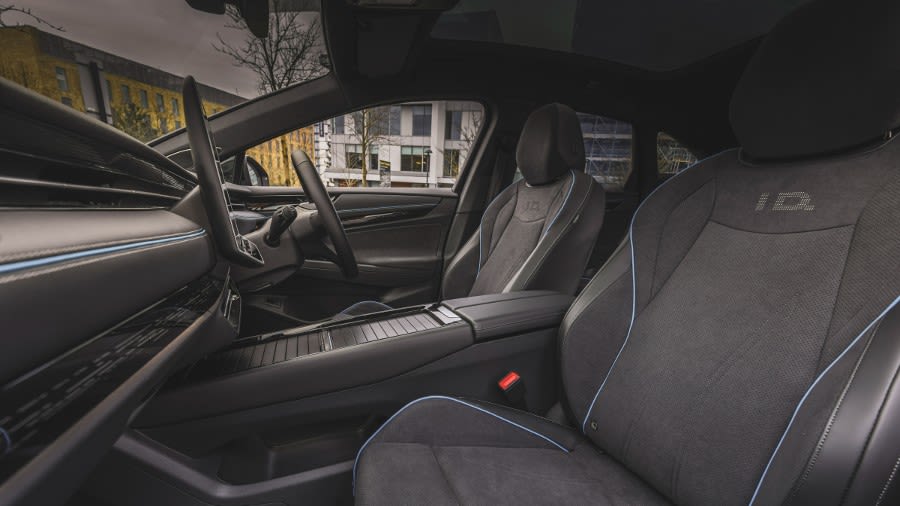
Practicality & Boot Space
The ID.7 is big – it’s almost five metres long – so there’s plenty of space on board. Inside, the driver and front passenger get more than enough room to get comfortable, while there’s enough space in the rear seats to accommodate two adults without too much trouble. Admittedly, headroom isn’t brilliant for those over about six feet tall, but anyone else will be more than comfortable enough. Rear legroom, in particular, is especially impressive.
Storage in the cabin is less than exemplary, though, with a decidedly cramped glovebox for right-hand-drive cars. Still, the boot is big, measuring 532 litres with all five seats in place, and it only grows when you fold the back seats down. However, there’s no ‘frunk’ under the bonnet, which might put some people off, but it really isn’t necessary when there’s that much space in the boot – and that much room under the boot floor.
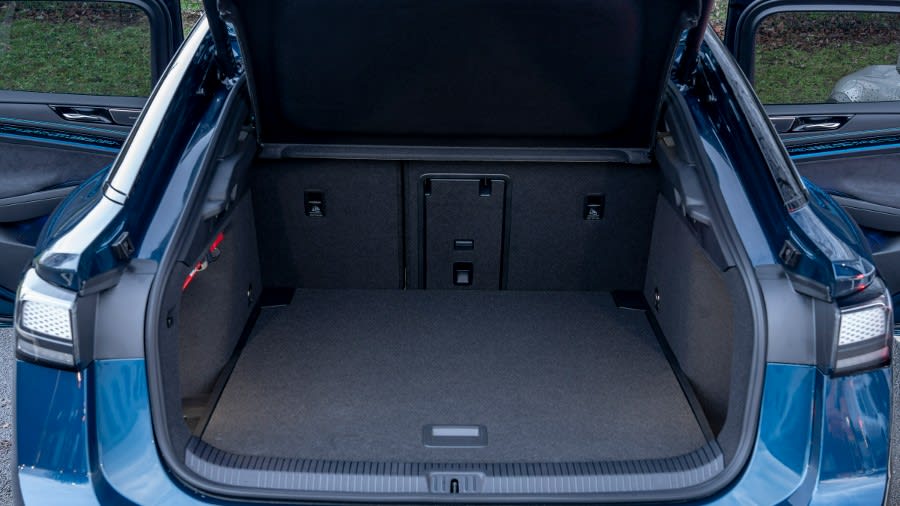
Safety
The ID.7 was recently crash-tested by Euro NCAP, and it performed incredibly well, managing a top five-star rating. Particularly impressive was its 95% score for adult occupant protection, but it scored really well across the board. Solid child occupant and vulnerable road user protection scores all helped, along with a decent showing from the safety assistance tech.
Speaking of which, there’s plenty of that in the ID.7. Not only do you get the clever head-up display, which can pick out hazards, other vehicles and lines on the road, but you get all the usual safety features, including autonomous emergency braking to stop the car automatically if needs be, and lane departure warning. There’s blind-spot monitoring, too, which is arguably the most useful feature of all, aside from perhaps the parking sensors and manoeuvring camera. Naturally, they’re also thrown in as standard.
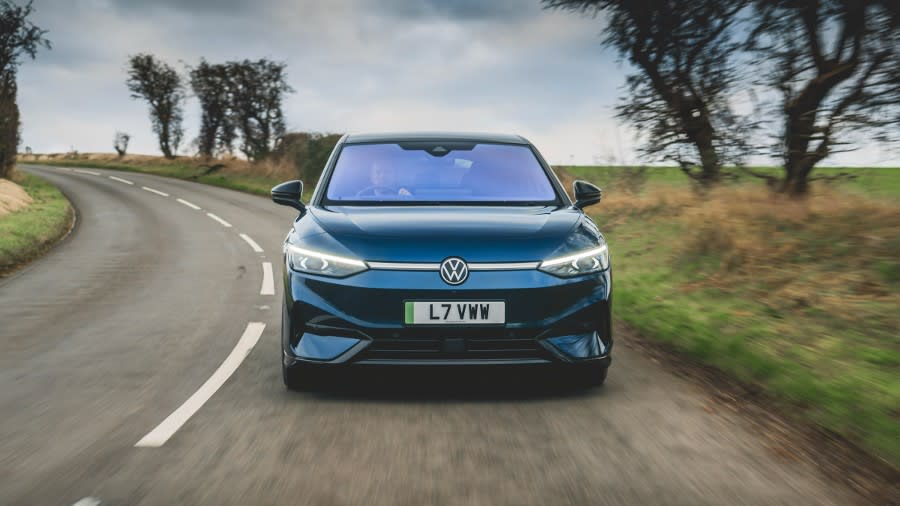
Options
At launch, there isn’t much in the way of choice when it comes to equipment. VW is offering the ID.7 in Match trim, and you can take it or leave it. There was a Launch Edition car for those who jumped on the bandwagon early, but for most it’s Match or nothing.
Not that that’s a problem, because the Match is incredibly well equipped for what has classically been a mid-range trim level in Volkswagen’s stable. In the ID.7, that means you get the head-up display and the massive touchscreen all as standard, while there are alloy wheels, heated and ventilated seats and a reversing camera. You can’t get much more, and you don’t want much more, but VW will sell you a handful of options.
Perhaps the most interesting of these is the panoramic sunroof, which has a kind of electrical frosting in it, allowing you to make it clear or translucent depending on your whim. And you can control it using your voice, by simply asking the on-board voice assistant (included as standard) to make the change. Other options include wheel designs and paint, with customers offered a single-tone black or black over grey, white, silver or blue. The Aquamarine Blue will likely be the colour of choice for many.
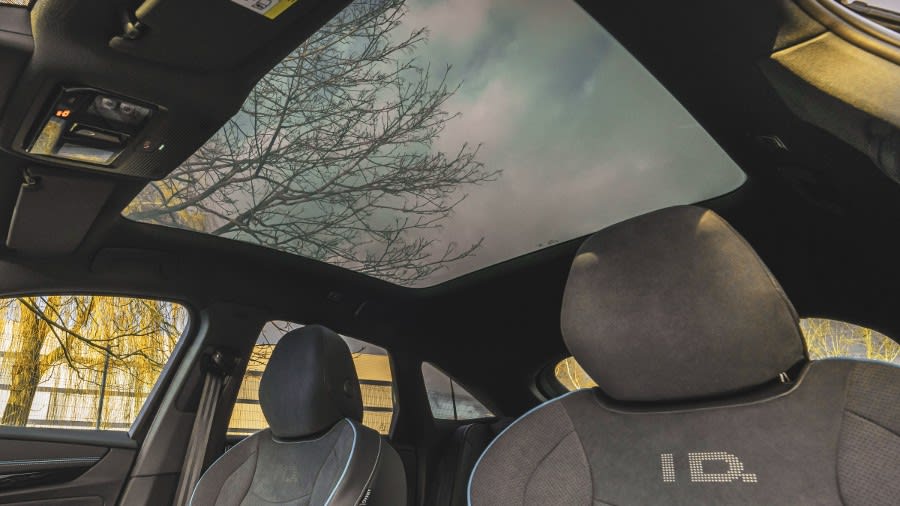
Rival Cars
At the moment, the ID.7’s cadre of rivals is fairly small, but it’s growing all the time. Direct rivals – by which we mean mainstream or semi-premium electric saloons – are few and far between, because the likes of Mazda, Ford and Skoda have not yet launched such products. But the premium brands offer plenty of alternatives, and the magic of leasing means the price difference isn’t necessarily as big as the RRP might suggest.
Team that with the fact VW is stacking the ID.7 with kit and it’s more premium than other VW ID. products, and you’re left considering cars such as the BMW i4 (below), which is a fabulous electric fastback, and its bigger brother, the i5. Strangely, given the i4 is the older, it’s the more compelling of the two cars, offering a great driving experience with premium quality and ample range, but the i5 is still a technical tour de force.
.jpg)
Other alternatives include the Mercedes-Benz EQE, which is expensive but offers enormous range, and the Genesis Electrified G80, which is a fabulously comfortable and efficient luxury car, but lacks space in the back.
And what electric car discussion is complete without mention of Tesla, which has made waves with its popular Model 3 and Model Y products. Both are flawed, but they appeal to customers with their anti-establishment branding and their huge tech promise.
If you want something a bit different from the norm, however, the Polestar 2 might be a better bet. With Volvo quality and tech, it’s a properly premium product, yet it offers handsome looks and an incredible range from the most efficient models.
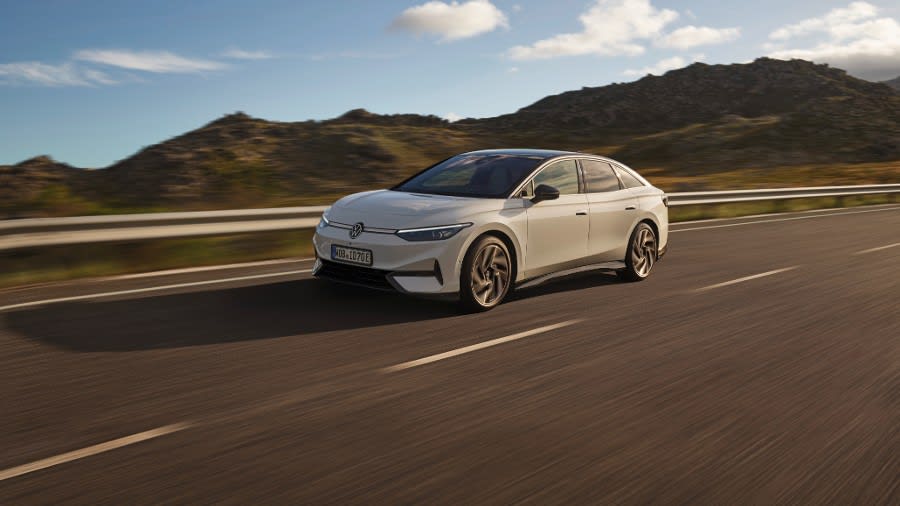
Verdict & Next Steps
In many ways, the ID.7 is the most convincing electric Volkswagen yet, thanks to its premium interior and improved infotainment system, but it still isn’t perfect. A more ergonomic dashboard would still be welcome and the more efficient heat pump should really be fitted as standard, but otherwise it’s a car that’s more or less problem-free. So while it may not be the most exciting thing on four wheels, it’ll do the job for a broad range of customers, and we’re expecting it to be a popular choice.
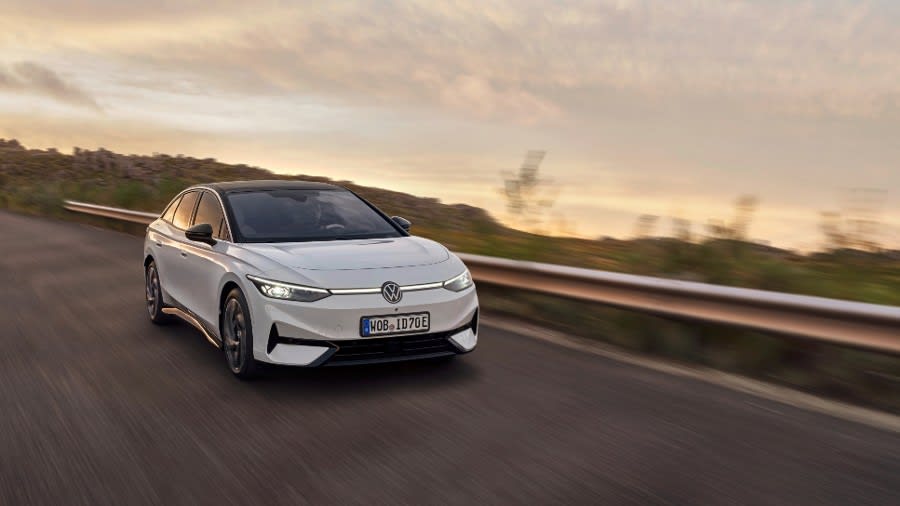
Where to next?
View latest Volkswagen ID.7 lease deals - from just £492 per month inc VAT**.
Call us on 0118 3048 688 or hit the green 'Enquire' button for more details.
Looking for a great leasing deal? Check out our incredible range of Special Offers and Lease Deals.
New Saloon? Read our latest Reviews and find the right model for you.
Want to know more about leasing? Take a look at our comprehensive Leasing Guides.
Interested in everything motoring? Why not catch up on all the latest Car Leasing News.
**Score based on Select’s unique meta score analysis, taking into account the UK’s top leading independent car website reviews of the Volkswagen ID.7.
**Correct as of 08/04/2024. Based on 9 months initial payment, 5,000 miles annually, over a 24 month lease. Initial payment equivalent to 9 monthly payments, or £4,427.91 (Plus admin fee) Ts and Cs apply. Credit is subject to status.
